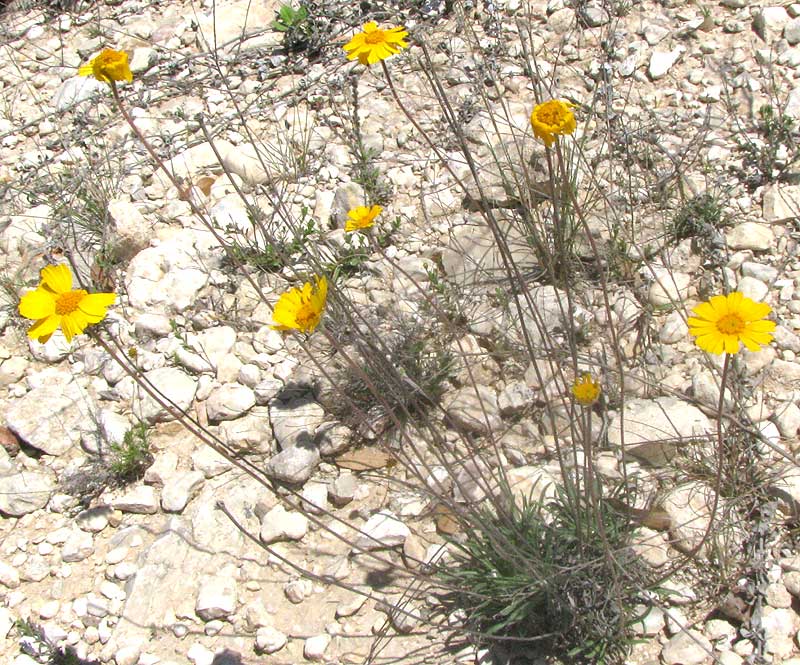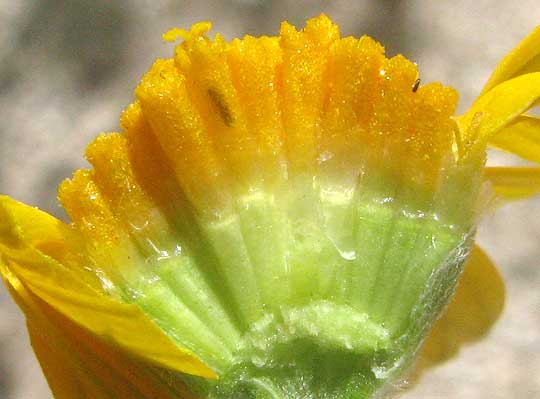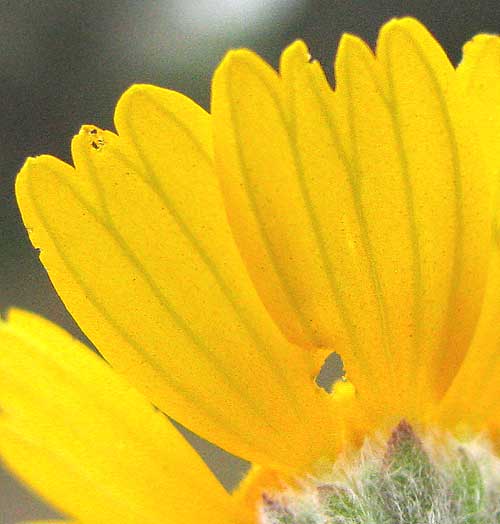Excerpts from Jim Conrad's
Naturalist Newsletter

from the the April 21, 2013 Newsletter issued from the Frio Canyon Nature Education Center in northern Uvalde County, southwestern Texas, on the southern border of the Edwards Plateau; elevation ~1750m (~5750 ft); N29.62°, W99.86°; USA
FOUR-NERVE DAISY
Suddenly there are so many new wildflowers appearing that I can't keep up with them. However, when I tell the locals how impressed I am by the wildflower show, they tend to shake their heads and maybe show me pictures of the Dry Frio Valley this time last year, when the drought wasn't as bad, and the valley was carpeted with gaudy wildflower color. As far as the locals are concerned, this year the wildflowers just aren't appearing, because of the drought.
Still, there are enough to keep me happy. One of the most common species in sun-baked openings on the rocky, lower slopes of our limestone hills and sometimes even along the road is the foot-tall member of the Composite or Daisy Family shown above.
To look so perky after a full day of full sunlight and an afternoon temperature of 95°F (35°C), this is clearly a tough little plant, one highly adapted for its environment. However, it's just one of a jillion little yellow-flowered daisies, so it took awhile to figure out this one's identity. First, I broke apart a flower head and saw what's shown below:

The greenish cylinders packed so closely below the disk flowers' golden corollas are the future achene-type fruits. Diagnostic features include the fact that the little mound the immature achenes arise from, the "receptacle," is not high enough to be "columnar," nor so low as to be "flat." The future achenes themselves are not separated from one another by chaffy bracts called paleae, but at their tops each one wears a crown of six or so sharp scales, which make up the pappus. Often the pappus consists of slender, white hairs, sometimes of long, barbed spines, sometimes there is no pappus... For identification purposes, these are important details.
Beneath the flower head the very fuzzy, overlapping involucral bracts, or phyllaries, also are distinctive in that they are all more or less the same length and alternate with one another.
These and other features led me to the genus Tetraneuris, consisting of nine species native to North America, often referred to collectively as bitterweeds. The name Tetraneuris means "four-nerved," and those four nerves are seen gracing each ray-flower corolla below:

In this part of the world we have two commonly occurring Tetraneuris species with very similar flowers, but different growth forms. Tetraneuris linearifolia is an annual herb with a branching stem, while Tetraneuris scaposa is a perennial with all its leaves forming a rosette at the base of long, slender, leafless flower-head stems arising from a woody base.
You've seen that our plants' flower heads arise on leafless peduncles issuing from leaf rosettes. I can tell you that if you finger the rosette bases you can feel the hard, knotty woodiness, which is convincingly not herbaceous. Therefore:
TETRANEURIS SCAPOSA, one of two species we can call Four-nerve Daisies. Other common names found for our species include Hymenoxys, Stemmy Four-nerve Daisy, Yellow Daisy and Bitterweed, though the last two names are applied to several other species as well. Our Tetraneuris scaposa occurs in the south-central US from Kansas and Colorado south through New Mexico and Texas deep into arid northern and central Mexico.
In Ethnobotany of The Zuñi Indians published by the Smithsonian Institution in 1908 and 09, I read that the Zuñi used to make an infusion of this species by soaking entire plants in cold water for several hours. This cured sore eyes and certain skin problems.